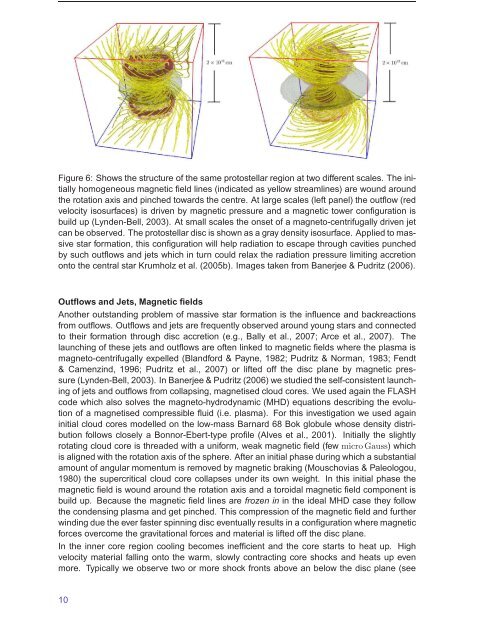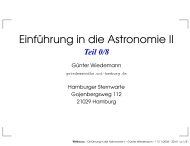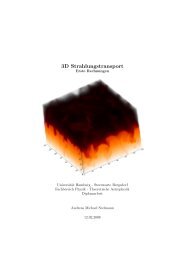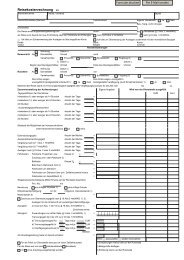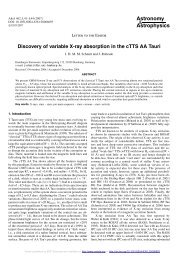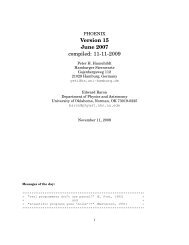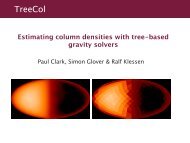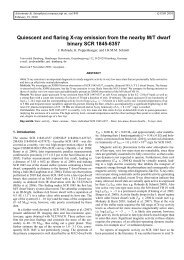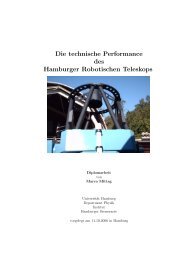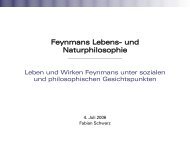Emmy Noether Application
Emmy Noether Application
Emmy Noether Application
You also want an ePaper? Increase the reach of your titles
YUMPU automatically turns print PDFs into web optimized ePapers that Google loves.
Figure 6: Shows the structure of the same protostellar region at two different scales. The initially<br />
homogeneous magnetic field lines (indicated as yellow streamlines) are wound around<br />
the rotation axis and pinched towards the centre. At large scales (left panel) the outflow (red<br />
velocity isosurfaces) is driven by magnetic pressure and a magnetic tower configuration is<br />
build up (Lynden-Bell, 2003). At small scales the onset of a magneto-centrifugally driven jet<br />
can be observed. The protostellar disc is shown as a gray density isosurface. Applied to massive<br />
star formation, this configuration will help radiation to escape through cavities punched<br />
by such outflows and jets which in turn could relax the radiation pressure limiting accretion<br />
onto the central star Krumholz et al. (2005b). Images taken from Banerjee & Pudritz (2006).<br />
Outflows and Jets, Magnetic fields<br />
Another outstanding problem of massive star formation is the influence and backreactions<br />
from outflows. Outflows and jets are frequently observed around young stars and connected<br />
to their formation through disc accretion (e.g., Bally et al., 2007; Arce et al., 2007). The<br />
launching of these jets and outflows are often linked to magnetic fields where the plasma is<br />
magneto-centrifugally expelled (Blandford & Payne, 1982; Pudritz & Norman, 1983; Fendt<br />
& Camenzind, 1996; Pudritz et al., 2007) or lifted off the disc plane by magnetic pressure<br />
(Lynden-Bell, 2003). In Banerjee & Pudritz (2006) we studied the self-consistent launching<br />
of jets and outflows from collapsing, magnetised cloud cores. We used again the FLASH<br />
code which also solves the magneto-hydrodynamic (MHD) equations describing the evolution<br />
of a magnetised compressible fluid (i.e. plasma). For this investigation we used again<br />
initial cloud cores modelled on the low-mass Barnard 68 Bok globule whose density distribution<br />
follows closely a Bonnor-Ebert-type profile (Alves et al., 2001). Initially the slightly<br />
rotating cloud core is threaded with a uniform, weak magnetic field (few micro Gauss) which<br />
is aligned with the rotation axis of the sphere. After an initial phase during which a substantial<br />
amount of angular momentum is removed by magnetic braking (Mouschovias & Paleologou,<br />
1980) the supercritical cloud core collapses under its own weight. In this initial phase the<br />
magnetic field is wound around the rotation axis and a toroidal magnetic field component is<br />
build up. Because the magnetic field lines are frozen in in the ideal MHD case they follow<br />
the condensing plasma and get pinched. This compression of the magnetic field and further<br />
winding due the ever faster spinning disc eventually results in a configuration where magnetic<br />
forces overcome the gravitational forces and material is lifted off the disc plane.<br />
In the inner core region cooling becomes inefficient and the core starts to heat up. High<br />
velocity material falling onto the warm, slowly contracting core shocks and heats up even<br />
more. Typically we observe two or more shock fronts above an below the disc plane (see<br />
10


